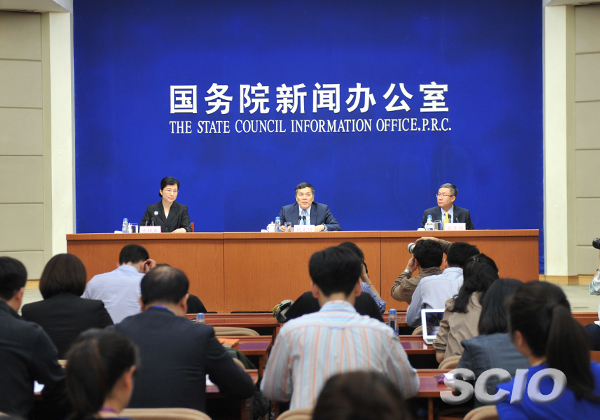SCIO briefing on trade and economic cooperation under B&R Initiative
The State Council Information Office holds a press conferenceon trade and economic cooperation under B&R Initiative in Beijing, on May 10.
Speakers:
Qian Keming, vice minister, Ministry of Commerce
Zhang Xingfu, head of the Department of Outward Investment and Economic Cooperation, Ministry of Commerce
Chairperson:
Xi Yanchun, vice director-general of the Press Bureau, State Council Information Office
Date:
May 10, 2017

Chairperson Xi Yanchun:
Ladies and gentlemen, good afternoon. Welcome to the press conference of the State Council Information Office. Today's conference will be about the Belt and Road Initiative.
We are delighted to invite Mr. Qian Keming, vice minister of commerce, to introduce trade and economic cooperation under the Belt and Road Initiative and answer some of your questions. Also present is Mr. Zhang Xingfu, the head of the Department of Outward Investment and Economic Cooperation of the Ministry of Commerce.
Now, let's welcome Mr. Qian to give his briefing.
Qian Keming:
Good afternoon, friends from the media.
In 2013, President Xi Jinping proposed the Belt and Road Initiative to boost global development and cooperation. It demonstrated China's willingness to shoulder its responsibilities as a large and important country.
With the principles of extensive consultation, joint contribution and shared benefits, the Initiative features openness, inclusiveness and win-win cooperation. This fulfills the expectations of countries along the route, with the aim of creating a community of a shared future. So far, the Initiative has received positive responses from more than 100 countries and international organizations.
Unimpeded trade is a major issue under the Belt and Road Initiative. We have made notable achievements in the following five aspects.
Regarding trade, we have actively boosted mutual market openness and increased trade facilitation. Various expositions, including the China-ASEAN Expo, China-South Asia Expo, China-Eurasia Expo and China-Arab States Expo, have played their role in facilitating interaction between businesses along the Belt and Road and helped them enjoy the opportunities created by the Initiative. From 2014 to 2016, trade between China and countries along the routes of the Belt and Road enjoyed a growth rate faster than the global average, reaching 20 trillion yuan in total regarding investment and cooperation, we have continually improved services to encourage more Chinese businesses to invest in countries along the route. Between 2014 and 2016, the total direct investment made by Chinese businesses in those countries surpassed US$50 billion, and the contractual value of new construction projects reached US$304.9 billion. Besides, we have attracted businesses from countries along the Belt and Road to invest in China by offering them wider market access and a comfortable business environment.
Regarding major projects, we have worked with related parties to promote smooth progress in various projects. The China-Laos Railway, the second phase of Pakistan's Karakoram highway and the Karachi-Lahore motorway are under construction. The oil and gas pipelines joining China with Russia, Kazakhstan, Myanmar and other countries are either under construction or already in operation.
Regarding overseas business cooperation zones, Chinese businesses have invested more than US$18.5 billion in 20 countries to build 56 such zones. These have generated about US1.1 billion in tax revenue and created approximately 180,000 jobs for the host countries. The China-Belarus Industrial Park has become a landmark project in the Silk Road Economic Belt. Smooth progress has been made in the building of the Suez Economic and Trade Cooperation Zone in Egypt, the Thai-Chinese Rayong Industrial Zone and Cambodia's Sihanoukville Special Economic Zone, among others. Regarding free trade areas, we have signed free trade agreements with ASEAN collectively, along with Singapore, Pakistan and other international organizations and countries along the route. Agreement was reached last July on upgrading the China-ASEAN free trade zone. A free trade agreement is going to be signed with Georgia. Currently, we are working on negotiations over the Regional Comprehensive Economic Partnership (RCEP) and on negotiations over free trade zones with Israel, the Maldives, Sri Lanka, the Gulf Cooperation Council, among others.
Today, products made in China, projects undertaken by China and services offered by China have become increasingly popular in countries along the Belt and Road. More and more products, services, technologies and investments have flowed into China from those countries. Tangible achievements have been reached in trade and economic cooperation; new energy has been injected into those countries for economic development; new momentum has been provided for the development of an open world economy; innovative modes have been created for economic globalization.
Now, I'd like to answer your questions with my colleague.
Xi Yanchun:
Thank you, Mr. Qian. Now the question session begins. Please identify your media outlets before raising questions.

